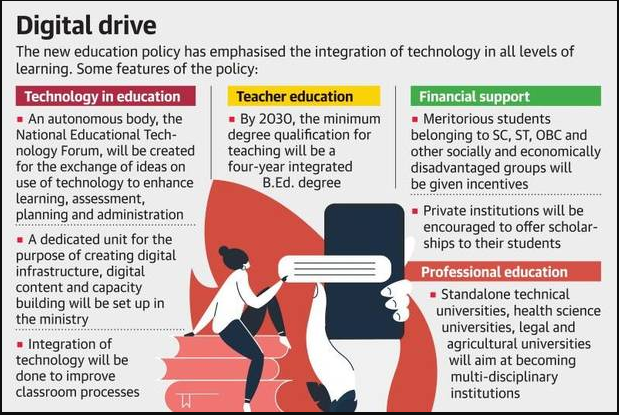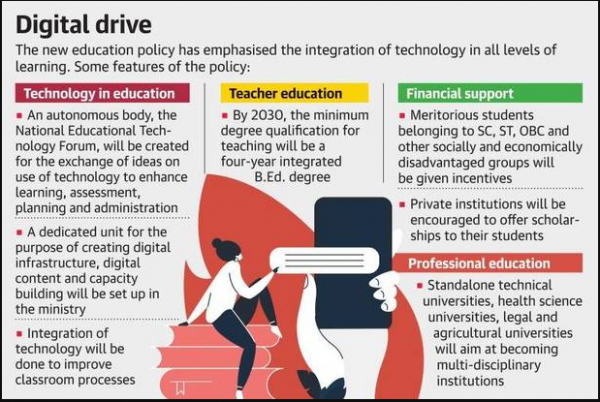Wendy Williams will not kiss and no more sex scenes during Quarantine Time
- 30-04-2020
- News

The New Education Policy 2020 approved by Union Cabinet on July 29, 2020 (NEP 2020) has introduced a sea-change in school and higher education sectors of the country. These reforms are aimed at transforming our hitherto stagnant 34-year-old National Policy on Education (NPE), 1986 and are based on the pillars of "access, equity, quality, affordability and accountability", in words of our PM Narendra Modi.
The reforms and policies announced under NEP 2020 garnered mixed responses receiving both appreciation as well as strong criticism from state governments, teaching community and educationists across the nation. CPI(M) general secretary Sitaram Yechury accused Narendra Modi Government for violating the rights of the States and destroying the country’s education system by imposing the new policy in middle of COVID crisis without discussion in Parliament which was assured earlier.
Here is a synopsis of pros and cons of some broad areas the policy focuses on:
School Education
The changes in school education includes a pre-primary education curriculum i.e. 5+3+3+4 model, reduced course content, increased focus on vocational and multi-disciplinary education aimed at holistic development of learners, a 360 degree holistic review report, multilingual and digital learning.
These school reforms are being considered ‘ground breaking’ making our revised structure in line with international educational standards. Introduction of digital learning has been welcomed as a progressive and forward-looking step, especially in post-COVID world. Observers feel that present education system is too exam centric and the decision to reduce the course content emphasizing just the core areas along with dilution of annual board examinations will enable students sharpen their practical skills rather than rote learning. Flexibility to choose subjects across streams will help getting away from the present model of being ‘typecast’ for life based on the subject chosen in school.
However, as they say ‘it’s easier said than done’, experts believe that it is one thing to announce the policy and another to execute it. The implementation of NEP 2020 demands huge investments in infrastructure and change in orientation of all stakeholders to make it a success, be it households, students, administrators or bureaucrats. The government targets to increase the public investment in education sector to 6% of GDP from present 4.6%, which however, is still being considered insufficient. As per KR Shyam Sundar, Professor, HRM Area, XLRI Jamshedpur, "We are still focusing on the 6 percent milestone that was set 55 years back... If we want to achieve the changes that are contemplated, it's time we revise it upwards,"
Educationists believe that introduction of vocational courses in school curriculum might be a good move for children living in urban areas and metro cities but kids from rural areas, many of whose parents follow these professions, will be entrapped in these jobs. This will fail the whole purpose of sending them to school, to acquire new skills and break the vicious cycle of poverty.
Introduction of regional or local languages as a medium of instruction till Grade 5 on one hand promotes home language, Indian knowledge system, culture, and values; but at the same time raises concerns on the capability of such students to compete in the modern business world which is largely driven by the English language. Teaching in one’s mother tongue should not undermine the value of teaching English in schools.
Higher Education
In higher education, the major reforms include emphasis of Holistic Multidisciplinary Education with multiple entry-exit points, option of common entrance exams (CEE) for universities, formation of Academic Bank of Credit (ACB); a common regulatory body for entire higher education - Higher Education Commission of India (HECI); National Curriculum Framework for Teacher Education, NCFTE 2021; focus on professional education, 100% youth and adult literacy and so on.

The concept of a Multidisciplinary Education and Research University (MERU) will help IIMs and IITs to expand into other departments like medical etc. allowing them to admit more students. Earlier due to the limited structure of our IIMs and IITs, despite having ample talent, they were unable to figure in the top 100 institutes of the world. At the same time, introduction of multi-disciplinary graduation courses would help students connect better with the outer world making them more job worthy.
Allowing foreign universities to operate in India would open our door to world excellence and enable students who are cannot go abroad due to multiple reasons to get global exposure. At the same time, the government is being blamed for commercialization and corruption by permitting foreign direct investment in education. This will also increase the financial burden to the students, thus increasing the cost of education.
Multiple entry-exit points and the credit bank on one hand give students flexibility in managing their education and financial needs hand-in-hand but at the same time raises a question of its implications when people are in and out of the university instead of being continuously present for 3-4 years. "While it gives academics the luxury to guide and mentor students for a longer period of time, it can also lead to their relationship becoming impersonal and transactional. That is a challenge we need to be aware of," says Partha Chatterjee, Head of Department of Economics at Shiv Nadar University
With autonomy of colleges and phasing away of the need to get affiliates, the ability of such colleges like those in Tier 2 cities, to build up their administrative, financial and academic capability is questionable. Replacement of the University Grants Commission with HECI has also received strong opposition from The Delhi University Teachers’ Association “Our opposition to the draft NEP rested, among other things, on its proposal to dismember universities and hand over every higher educational institution to a Board of Governors.,” DUTA president Rajib Ray said.
Other Areas
Other key areas which NEP 2020 includes the introduction of technology in education through National Educational Technology Forum (NETF); aiming to increase Gross Enrolment Ratio in higher education, including vocational education, from 26.3% in 2018 to 50% by 2035; creation of Gender Inclusion Fund to provide equitable quality education to all girls and transgender students.

To sum up, The New Education Policy aims to transform India into a vibrant knowledge society and global knowledge superpower by making both school and college education more holistic, flexible, multidisciplinary, suited to 21st century. Proper implementation of the reforms and ideas envisioned in the NEP 2020 can fundamentally transform India. However, it is just another visionary document unless executed properly gaining consensus of the state governments, opposition parties and administrators. In words of Kerala State Higher Education Council member secretary Rajan Varughese, “It ignores the balance of power in the Constitution and vests all decision-making powers the Executive, while leaving nothing for Parliament and State legislatures that have hitherto been actively involved in creating many institutions and resources for educational development”.